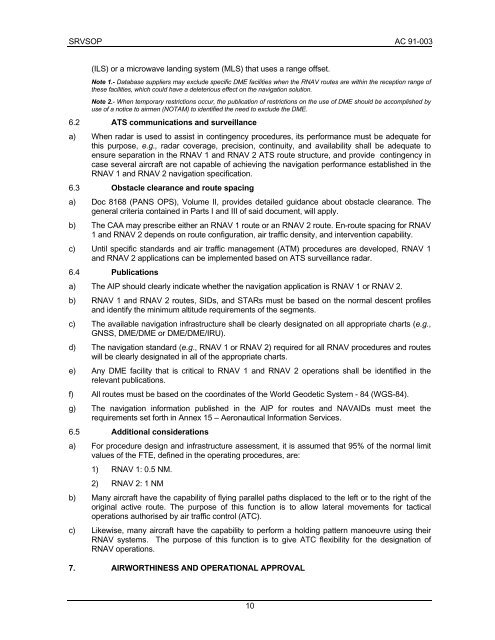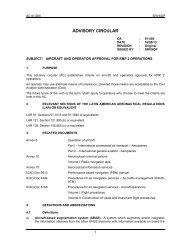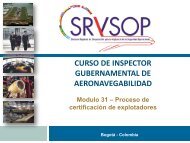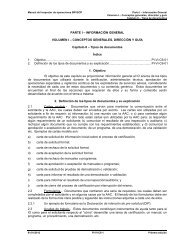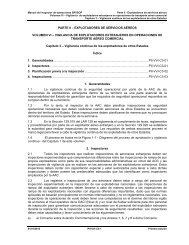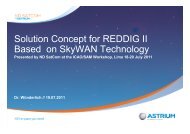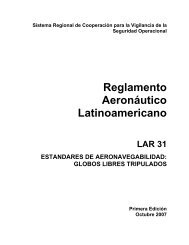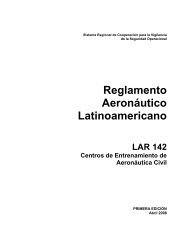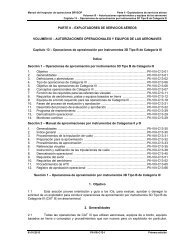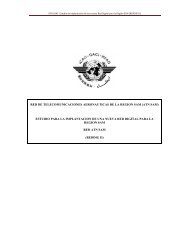ac 91-003 srvsop - ICAO
ac 91-003 srvsop - ICAO
ac 91-003 srvsop - ICAO
You also want an ePaper? Increase the reach of your titles
YUMPU automatically turns print PDFs into web optimized ePapers that Google loves.
SRVSOP AC <strong>91</strong>-<strong>003</strong><br />
(ILS) or a microwave landing system (MLS) that uses a range offset.<br />
Note 1.- Database suppliers may exclude specific DME f<strong>ac</strong>ilities when the RNAV routes are within the reception range of<br />
these f<strong>ac</strong>ilities, which could have a deleterious effect on the navigation solution.<br />
Note 2.- When temporary restrictions occur, the publication of restrictions on the use of DME should be <strong>ac</strong>complished by<br />
use of a notice to airmen (NOTAM) to identified the need to exclude the DME.<br />
6.2 ATS communications and surveillance<br />
a) When radar is used to assist in contingency procedures, its performance must be adequate for<br />
this purpose, e.g., radar coverage, precision, continuity, and availability shall be adequate to<br />
ensure separation in the RNAV 1 and RNAV 2 ATS route structure, and provide contingency in<br />
case several aircraft are not capable of <strong>ac</strong>hieving the navigation performance established in the<br />
RNAV 1 and RNAV 2 navigation specification.<br />
6.3 Obst<strong>ac</strong>le clearance and route sp<strong>ac</strong>ing<br />
a) Doc 8168 (PANS OPS), Volume II, provides detailed guidance about obst<strong>ac</strong>le clearance. The<br />
general criteria contained in Parts I and III of said document, will apply.<br />
b) The CAA may prescribe either an RNAV 1 route or an RNAV 2 route. En-route sp<strong>ac</strong>ing for RNAV<br />
1 and RNAV 2 depends on route configuration, air traffic density, and intervention capability.<br />
c) Until specific standards and air traffic management (ATM) procedures are developed, RNAV 1<br />
and RNAV 2 applications can be implemented based on ATS surveillance radar.<br />
6.4 Publications<br />
a) The AIP should clearly indicate whether the navigation application is RNAV 1 or RNAV 2.<br />
b) RNAV 1 and RNAV 2 routes, SIDs, and STARs must be based on the normal descent profiles<br />
and identify the minimum altitude requirements of the segments.<br />
c) The available navigation infrastructure shall be clearly designated on all appropriate charts (e.g.,<br />
GNSS, DME/DME or DME/DME/IRU).<br />
d) The navigation standard (e.g., RNAV 1 or RNAV 2) required for all RNAV procedures and routes<br />
will be clearly designated in all of the appropriate charts.<br />
e) Any DME f<strong>ac</strong>ility that is critical to RNAV 1 and RNAV 2 operations shall be identified in the<br />
relevant publications.<br />
f) All routes must be based on the coordinates of the World Geodetic System - 84 (WGS-84).<br />
g) The navigation information published in the AIP for routes and NAVAIDs must meet the<br />
requirements set forth in Annex 15 – Aeronautical Information Services.<br />
6.5 Additional considerations<br />
a) For procedure design and infrastructure assessment, it is assumed that 95% of the normal limit<br />
values of the FTE, defined in the operating procedures, are:<br />
1) RNAV 1: 0.5 NM.<br />
2) RNAV 2: 1 NM<br />
b) Many aircraft have the capability of flying parallel paths displ<strong>ac</strong>ed to the left or to the right of the<br />
original <strong>ac</strong>tive route. The purpose of this function is to allow lateral movements for t<strong>ac</strong>tical<br />
operations authorised by air traffic control (ATC).<br />
c) Likewise, many aircraft have the capability to perform a holding pattern manoeuvre using their<br />
RNAV systems. The purpose of this function is to give ATC flexibility for the designation of<br />
RNAV operations.<br />
7. AIRWORTHINESS AND OPERATIONAL APPROVAL<br />
10


